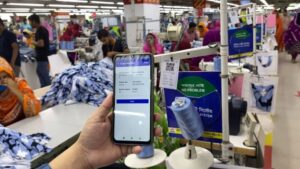The Covid-19 pandemic has brought in many a change but one thing that hasn’t changed much is Bangladesh garment industry’s appetite for technology adoption, feels Johan Grieten, the Global Sales Director, R&D Advisor and Member of the Board of IMB and Founder of IMB Bangladesh.
Back to Bangladesh after a gap of almost two years owing to the devastating pandemic that has restricted people’s movement on account of countries closing their borders to prevent the spread of the pandemic, the Global Sales Director of the leading Chinese sewing technology brand, which is renowned for its denim sewing automats and counts the top of the line denim manufacturers of Bangladesh amongst its clientele, Johan spoke to Apparel Resources (AR) on the sidelines of the Garmentech event as he shared his views on the issues that matter the most – markets, manufacturing, technology and its future in the changing milieu.
AR: This is the first time you are in Bangladesh after the pandemic; your views.
Johan Grieten: I am really very happy to be back in the country. Given a preference, I would choose Bangladesh over any other to come over and visit. Bangladesh boasts of a very vibrant apparel sector and is a huge potential market from IMB’s perspective.
Garment makers in Bangladesh are always ready to invest in technology/automation compared to even India, which is very price-sensitive. We already have strong roots in Bangladesh with the top denim manufacturers under our clientele even as during the Covid-19 pandemic, to cater to the market needs, we also diversified our focus to PPE gowns and coveralls.
AR: Post-pandemic, the market dynamics have changed even as Bangladesh is also strongly focusing on moving up the value chain. How is IMB adapting to the changing milieu?
Johan Grieten: It is really nice to see Bangladesh moving up the value chain and getting into new and exciting product categories like suits, lingerie, outerwear and so. Pacific Denim, for example, which is one of our biggest clients in the country, has also expanded into suits.
As far as IMB is concerned, we did a lot of R&D during the pandemic period and came up with several new offerings. Now is the time for us to reach out to the existing and potential clients and tell them about new developments from IMB.
Even though denim continues to be the focus as we can offer a complete package for denim (A-Z in terms of machines/solutions), but as you know Bangladesh is very strong in knits, which means demand for machines that are meant for knit products is just as massive. We already have three machines for knits and work is on for another five, which would be introduced in near future.
We had to get into the knit section not only for Bangladesh but for other countries as well, where knit is very popular and growing very strongly and, if we don’t shift focus on knits, we will be missing out on a massive chunk of the market.
Currently we have Automatic Circumferential Bottom Hemming Sewing machine, IMB Side Sliding Foot Device and IMB Heat Transfer machines for the knit section.
Also, in the medical solution section, we have IMB Hot Air Sealing Machine,IMB LACE MACHINE For Protection Suit Side Seam Jointing By Ultrasonic and IMB KN95, N95 Edge Close/Welting Ultrasonic Machines.
For shirts, we have IMB Automatic Button Feeder(With Machine Head), IMB Automatic Sleeve Placket Setter, IMB Automatic Shirt Pocket Setter, IMB Automatic Button and Buttonholing Indexer and IMB Shirt Cuff Top-Stitch Unit.
We have also come up with a few machines for suits; and the advantage is that one can use the same for chinos as well. After the Garmentech event, I will be travelling to Chittagong, as the port city has a significant number of suit manufacturers.
“Garment makers in Bangladesh are always ready to invest in technology/ automation compared to even India, which is very price sensitive. We already have strong roots in Bangladesh with the top denim manufacturers under our clientele even as during the Covid-19 pandemic, to cater to the market needs, we also diversified our focus to PPE gowns and coveralls.” – Johan Grieten
AR: With so many new developments, IMB is undoubtedly on an inspiring growth trajectory. Your goals going forward?
Johan Grieten: The focus would be undoubtedly on business growth but setting a goal at this point of time would be a difficult proposition at least if we consider the host of developments that have taken place in the last couple of years or so.
There’s still a lot of uncertainty in the global market, partly due to political reasons not to mention the Russia-Ukraine war and the economic slowdown and recession that have already hit many countries hard.
AR: Technology is making progress by leaps and bounds. Keeping in perspective the garment industry, what would be that one aspect which you think will be vital going forward?
Johan Grieten: The future will be all about data. Data capturing and analysis in every aspect of garment making would be of paramount importance. For factories that want to move to the level next, it would be not about saving minutes but seconds and for such operations, practices and decision-making, everything has to be data-driven.
AR: How is IMB aligning its offerings, keeping data-driven manufacturing in mind?
Johan Grieten: Today all our machines are interconnected and one can get whatever data is needed in their system to optimise operations and increase efficiencies. Whether you are making a jacket, a trouser or outerwear, data collection process is the same. So I would say data is the most important aspect of production.
But, to the desired result and traction, a lot will depend on the accuracy of data and its proper analysis.
AR: Technology being the essence of growth and development, why is it that adoption of technology in garment industry is still somewhat behind other sectors?
Johan Grieten: I would say it is principally on account of price-point and affordability.
Just to give you an example, the robot arms, when they were discovered and brought into use some 15 years back, it cost a bomb, around US $ 2 million for each arm. First, the aviation industry used it and when the price-points became more affordable, the automobile industry was next to adopt it and now slowly and steadily the turn has come now for the apparel industry to make use of it.
No matter the rate of adoption, technology is going to be the future of the industry. The time has come when trousers will be made by technicians, not operators as everything will be done automatically. I am even hopeful, a day will come when technology will make such advancements that all you would need to do is feed fabric into the machine at one end and the complete garment will come out from the other.







